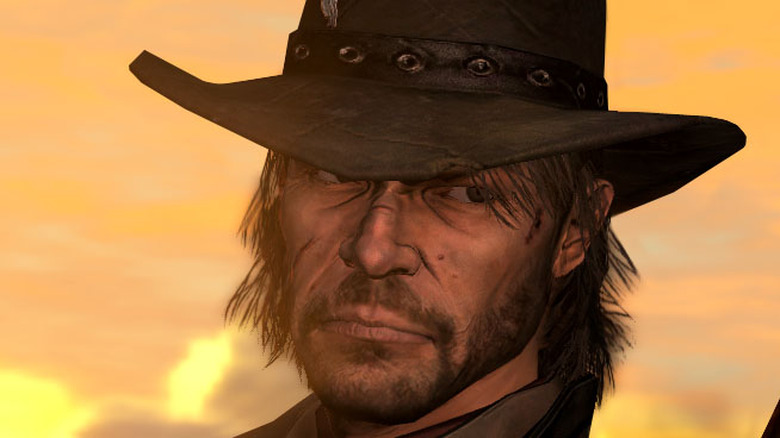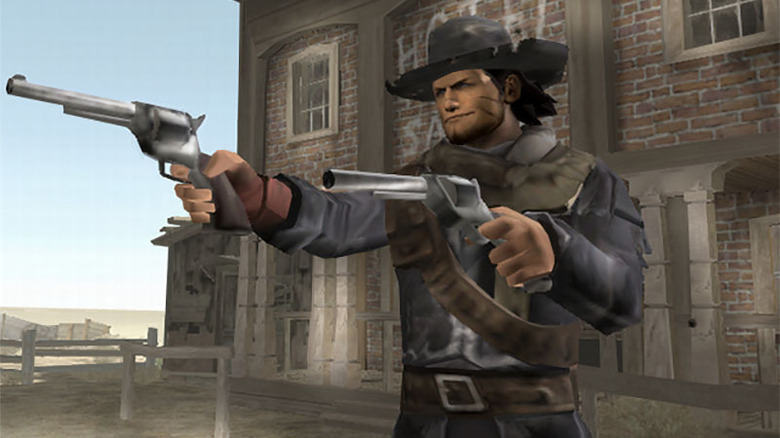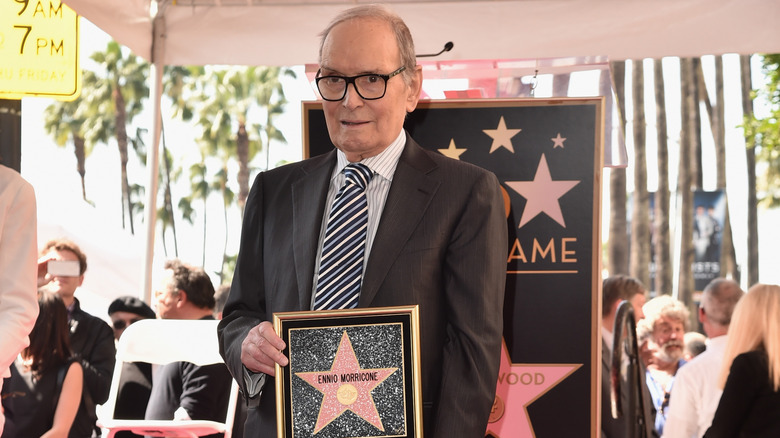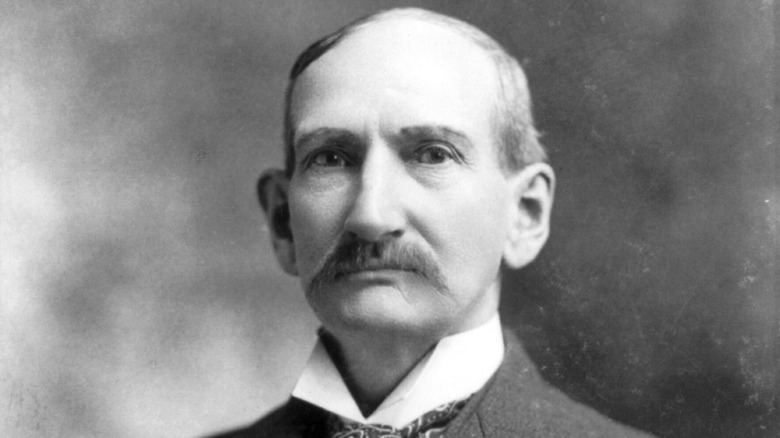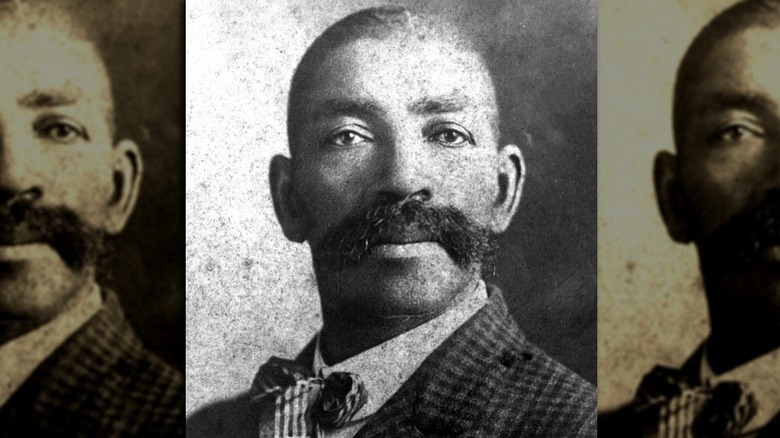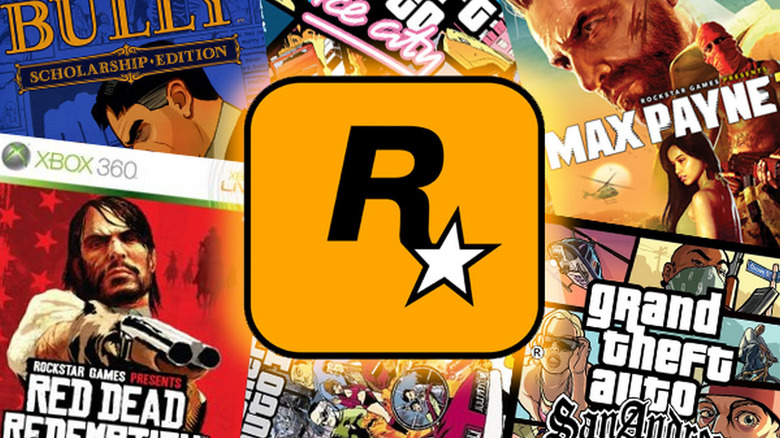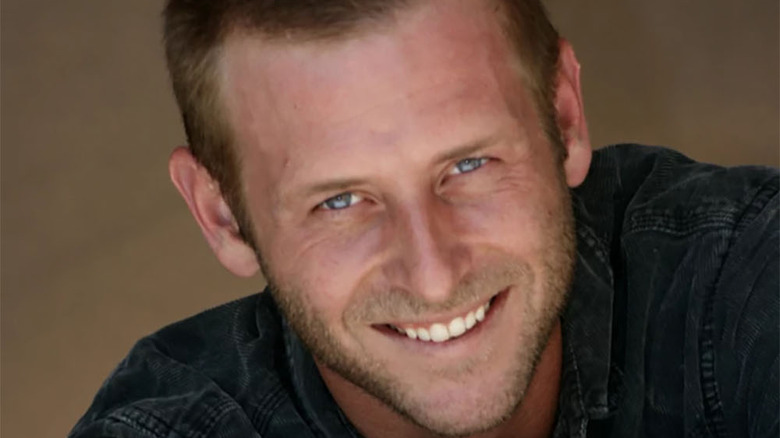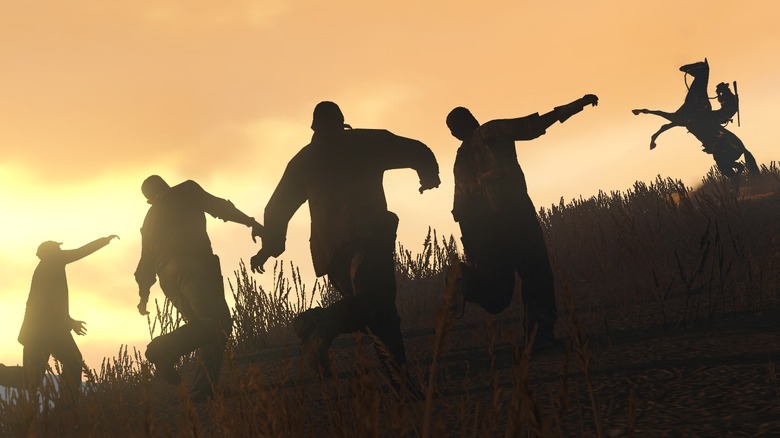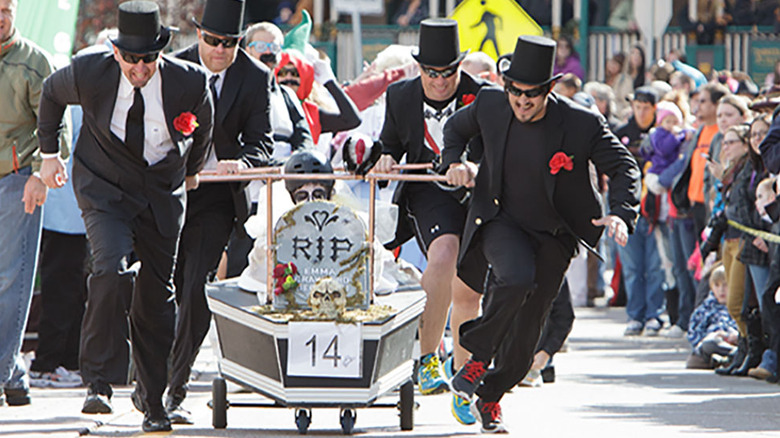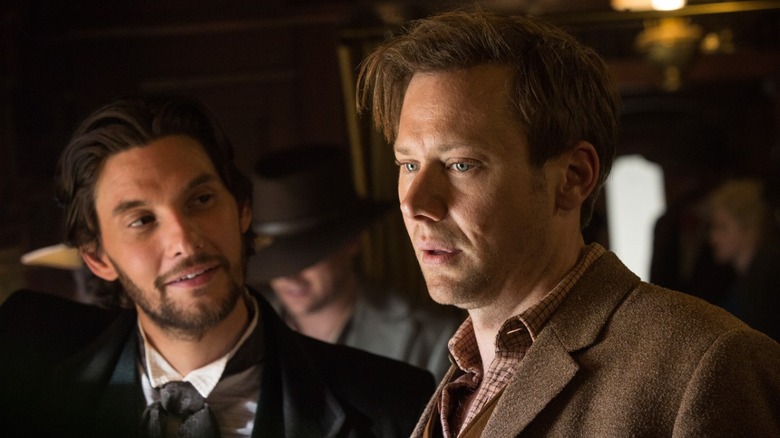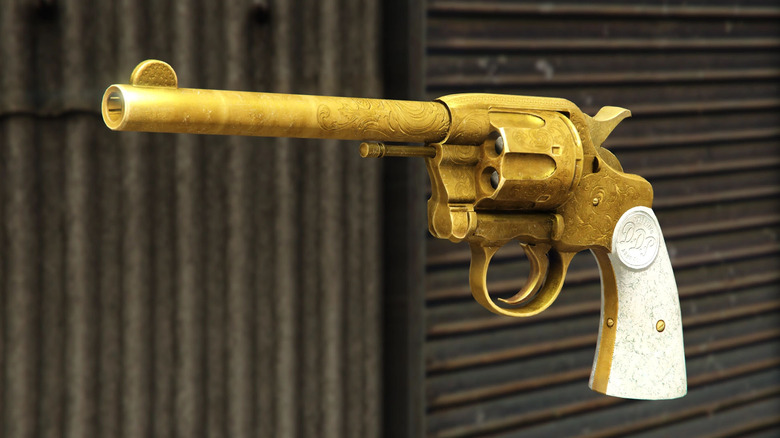The Untold Truth Of Red Dead Redemption
At first glance, Red Dead Redemption might look familiar, but don't be fooled: as real fans know, Red Dead Redemption is much, much more than Grand Theft Auto dressed up in an Old West disguise. It's a living, breathing, fully interactive Western in which you're the star. If you've ever watched an old John Wayne or Clint Eastwood joint and dreamed of hopping on a horse, strapping on a six-shooter, and wandering the plains, look no further. Red Dead Redemption is the series for you.
There's more to Red Dead than shootouts, train heists, and cattle rustling, though, and the game's behind-the-scenes journey was almost as tumultuous as the Wild West itself. Here are a few of Red Dead Redemption's best kept secrets, but keep an eye out. The desert is a big place, after all, and you never know what other mysteries you'll find out on the wide-open range.
Where there's Gun.Smoke, there's fire
In a different world, John Marston calls Mega Man, Ryu, and Phoenix Wright family. Red Dead Revolver, the third-person shooter that kicked off the Red Dead franchise, might've been published by Grand Theft Auto's Rockstar Games in 2004, but the game began life at Capcom, home to Street Fighter, Resident Evil, Monster Hunter, and many other classics.
In fact, at the outset, Red Dead Revolver wasn't just a Capcom joint. It was a spiritual sequel to one of Capcom's mostly-forgotten '80s arcade games, Gun.Smoke. Designed by Yoshiki Okamoto, who'd later go on to produce Final Fight and Street Fighter II, Gun.Smoke was an upward-scrolling shooter like Capcom's 1942 and Commando in which players controlled a rogue cowpoke and his twin pistols. Gun.Smoke's goal was simple — just survive while shooting everything that moves — and it bears little resemblance to the open-world western that Red Dead ultimately became. Still, if you squint, you might be able to spot its influence on Red Dead Revolver.
At any rate, in the early '00s, Rockstar Games bought Angel, the studio developing Red Dead Revolver, and quickly started sifting through its various projects. Capcom had already canceled Red Dead Revolver, but Rockstar decided that the game was worth a second look. Rockstar's staff loved movies, after all, and thought revitalizing the Old West shooter would be "a fun challenge." Ten months later, Red Dead Revolver was ready for mass consumption. The Red Dead franchise had officially begun.
The sounds of a spaghetti western
Under Capcom's watch, Red Dead Revolver was a pretty traditional Western, give or take a flying cowboy or two. The main character might've looked like Clint Eastwood, but the overall tone had more in common with Stagecoach or your typical John Wayne movie than the grimy European Westerns of the '60s and '70s.
So, naturally, when Rockstar took over, the company decided to dirty the thing up. That meant bringing the entire game more in line with Italy's gritty "Spaghetti Westerns," including classics like Sergio Leone's A Fistful of Dollars and The Good, the Bad, and the Ugly. To start, Rockstar added a film grain effect on top of all of Revolver's action, evoking the movies' low-budget roots, and then upped the ante by filling the soundtrack with tunes from actual Spaghetti Westerns.
After all, Leone's Man with No Name trilogy wouldn't be what it is without Ennio Morricone's iconic score, and music is a crucial part of the Spaghetti Western's signature vibe. Naturally, Morricone himself pops up on Red Dead Revolver's soundtrack a few times, where he's joined by accomplished composers like Bruno Nicolai, Luis Enríquez Bacalov, and others. Aside from the setting and some of the shooting mechanics, Red Dead Revolver doesn't have much in common with Red Dead Redemption, but as Revolver shows, Rockstar got the franchise's tone right from the very beginning.
A real-life hive of scum and villany
Red Dead Redemption isn't just a tribute to the Westerns that graced the silver screen. It's a monument to the real-life history of the American West, too. The locations that John Marston and his outlaw peers visit may be made-up, but Rockstar's staff spent a fair amount of time researching the actual Wild West, and there are all kinds of nods to many historical events in the game itself.
As such, it's hardly surprising that some of Red Dead Redemption's most memorable characters have roots in actual, real-life personalities, including the game's big bad. Edgar Ross, the Bureau of Investigation officer who holds John Marston's family hostage and forces him to return to his outlaw ways, is a thinly veiled analogue for Charles Joseph Bonaparte. In 1908, Bonaparte — who, yes, was related to the French emperor Napoleon — founded the Bureau of Investigation, the precursor to the FBI. By 1911, when Red Dead Redemption takes place, the BOI was playing a part in the Mexican revolution and containing skirmishes on the Texas-Mexico border.
That's not all. Frank James, the brother and confederate of infamous bank robber Jesse, provided some insights into Marston's character as a fellow ne'er-do-well gone straight. Tom Horn, a Pinkerton detective turned freelance assassin, served as a template for some of Red Dead Redemption's most bloodthirsty villains. Red Dead Redemption's cast might be memorable, but compared to the real thing? It's small potatoes.
When historical accuracy isn't fun
All that being said, Red Dead Redemption does make one major departure from reality: the Old West was really, really racist. Red Dead Redemption, not so much. That's just another part of Red Dead's cinematic legacy. Not only has Hollywood spent decades whitewashing the Wild West — John Wayne's character in The Searchers is based on Britton Johnson, a black man, while the Lone Ranger is awfully similar to Bass Reeves, the first black US Marshall posted west of the Mississippi — but when non-whites do appear, they're usually depicted as savages or idiots (or both).
Contemporary attitudes towards non-whites were even worse. Black cowboys, often recently freed slaves, had a much harder time than their white peers. Chinese laborers who worked in mines or on railroads endured never-ending prejudice in addition to horrific working conditions. White settlers, often with the help of the United States government, spent almost a century pushing America's native population towards extinction before the Wild West rolled around and, spoiler alert, when it did things didn't get any better.
It's an ugly part of US history, and one that Rockstar decided to avoid, for better or worse. On one hand, that's too bad: by downplaying the Old West's racial tensions, Rockstar is committing the same crime as countless Hollywood productions. On the other, the company doesn't have the best track record with this sort of thing. Maybe — just maybe — sidestepping the issue is best for everyone involved.
Party like a Rockstar, but try not to work like one
Red Dead Redemption is fun to play, but by all accounts, it wasn't very much fun to make. According to reports, Rockstar San Diego wasn't just a high-pressure workplace; for some employees, it bordered on abusive.
Right before Red Dead Redemption came out, an anonymous blogger who claimed to be the spouse of a Rockstar San Diego employee posted a scathing rebuke of the company on Gamasutra. The writer claimed that Rockstar San Diego employees were forced to work 12-hour days, six days a week, and that management's "dishonesty" was taking a harsh physical and mental toll on the employees' health. That author wasn't the only one speaking up, either. A few years after launch, another former Rockstar worker supported all those claims, and threw in another infuriating tidbit: in addition to the crazy hours, Rockstar employees weren't paid overtime.
Rockstar denied all of this, of course, but it's hard not to believe the flood of disgruntled workers. For one, Rockstar co-founder Sam Houser admitted that Red Dead Redemption's development was "a recurring nightmare." Secondly, Rockstar has a history of this kind of behavior: in April 2009, while Red Dead Redemption was still in development, Rockstar San Diego settled a lawsuit related to, you guessed it, unpaid overtime. Rockstar makes excellent games — Red Dead Redemption is one of 'em — but as a place to work? Eh, maybe not so great.
Whatever happened to the man who played John Marston?
In Red Dead Redemption, Rob Wiethoff played John Marston, and he's one of the big reasons why Marston remains one of the most interesting and complex video game characters ever. Wiethoff's performance is still considered one of the game industry's all-time greats.
You'd think that Wiethoff would've been able to parlay his Red Dead Redemption success into a lucrative career, but as it turns out, Wiethoff's big break ended up being his final role. It's hard to blame him. Before being cast as Red Dead Redemption's lead, the Seymour, Indiana native spent ten years in Hollywood trying to hack it as an actor. Wiethoff came to LA without any connections or formal acting training, and soon learned that show business is full of big talk and empty promises. Wiethoff had appeared in a few commercials when he got a call about a mysterious video game project, but little else.
When he arrived, he found men dressed in Army fatigues and executives who wouldn't share any information about the game in question. Wiethoff won the role anyway. For two years, Wiethoff visited the recording booth and donned a motion capture suit to bring John Marston to life.
By the time that Red Dead Redemption came out, Wiethoff had had enough. He moved back to Seymour and now works at an industrial supply company. It's not glamorous, but compared to Hollywood? Hey, at least it pays.
Rockstar's dream project, or an undead nightmare?
Anyone who's played any of the Grand Theft Auto games knows that Rockstar does crazy very well, but Red Dead Redemption's single-player DLC expansion, Undead Nightmare, takes things to the next level. Not only does the add-on fill Red Dead's Old West with zombies, but it throws in a bunch of other fantasy creatures, including sasquatches, chupacabras, and unicorns, too.
It's bonkers, and a little off-brand for Rockstar, which tends to keep the supernatural presence in its games confined to small hints and Easter eggs. So, how does something like Undead Nightmare happen? Well, according to Rockstar's Dan Houser, the company had wanted to make a zombie game for years. But zombie games come out all the time, and Rockstar waited until it could "find a way to make zombies interesting." As Houser tells GameSpot, "We thought we could do that ... by putting zombies into an existing universe, so the player gets to see how characters they already know respond to the madness of a zombie outbreak."
Besides, Houser says, the world of Red Dead Redemption is better suited to zombies than Grand Theft Auto's. Red Dead's gunplay is a lot stronger than GTA's, and the Spaghetti Western environments already recall the landscapes of '70s Italian horror flicks. John Marston makes for a better zombie-hunter than Niko Bellic or Carl "CJ" Johnson, too. He's already a bounty hunter. Turning him into OId West Ghostbuster is simply the next logical step.
Red Dead Redemption's celebrity corpse
Most of Red Dead Redemption's gravestones hide silly one-liners and Easter eggs — both Clint Eastwood and his most famous Western character, the Man with No Name, are immortalized in a pair of Red Dead headstones — but eagle-eyed fans have discovered that there's at least one real person buried in Red Dead Redemption's digital graves. At the church in Blackwater, one of the gravestones memorializes Emma Crawford, a woman who didn't make much of an impact while she was alive but went on to become one of the most famous corpses of all time.
Young Ms. Crawford settled in Manitou Springs, Colorado in 1889 after contracting tuberculosis. Unfortunately, she died just a couple of years later. Crawford was buried on a nearby mountain, but she didn't exactly rest in peace: by 1929, weather had battered at the hillside for decades, and during one particularly nasty storm, Emma's coffin came loose and slid down the hill.
In 1994, some members of the Manitou Springs' community decided to hold a festival dedicated to Emma's posthumous fame, and the "Emma Crawford Memorial Coffin Races" have been going strong ever since. Every year, teams gather in downtown Manitou and take turns pushing decorated coffins down the city's streets. There's also a parade, lots of costumes, and a $50 grand prize. It's all quirky as hell, and it's easy to see why Rockstar was drawn to it.
Yes, the Westworld people are Red Dead Redemption fans, too
Red Dead Redemption and Westworld, the theme park where HBO's uber-popular robot drama takes place, have a lot in common. Both are artificial worlds where regular people can live out their weirdest, most depraved Wild West fantasies. Westworld might be infinitely more dangerous than West Elizabeth and Nuevo Paraíso — no matter what you do, Red Dead Redemption's NPCs aren't going to rise up and try to kill you for real — but the parallels are clear, and more than one person has noticed.
As it turns out, the similarities aren't an accident. Westworld co-creators Jonathan and Lisa Joy Nolan actually played video games, including Red Dead Redemption, while developing the show. In fact, their experiences with Rockstar's games directly influenced some of Westworld's storylines. Lisa Joy likes to take her time and take in the sights while playing open-world games, and while Jonathan quips that she's "the world's most boring Grand Theft Auto player," her attitude helped inform the relationship between debauchery-driven Logan Delos and his future brother-in-law, the more restrained William.
Red Dead Redemption isn't the only game that's woven into Westworld's DNA, either. Jonathan Nolan cites a video by BioShock creator Ken Levine, in which the veteran game designer discusses coming up with plot threads that trigger-happy players will never experience, as the perfect metaphor for Westworld's robotic hosts. Westworld's citizens have thoughts and lives of their own, but most guests won't ever see them.
One big, happy shared universe
It took the better part of a decade, but in 2017, a group of Grand Theft Auto Online data-miners confirmed what Rockstar fans had been trying to prove for years: Red Dead Redemption and Grand Theft Auto take place in the same universe.
The big revelation comes courtesy of The Guru Team, the same people who finally solved Grand Theft Auto V's long-gestating UFO subplot. In October 2017, Rockstar dropped a big Grand Theft Auto Online update called The Doomsday Heist that cleared up many of GTA's ongoing mysteries. That wasn't all it did, however: it also added a few Red Dead Redemption 2 tie-ins to the mix. As the Guru Team discovered, Grand Theft Auto now had a small chest adorned with the Boles Overland Stagecoach Co. logo, which appeared in one of Red Dead Redemption 2's early trailers, along with a handwritten note and some references to a gold-plated six-shooter.
Rockstar came clean a few days later, unleashing a mission that requires players to go to an unmarked grave — one that's been around since John Marston walked the Earth — in order to find the long-lost weapon. Even better, once you have the gun, you can complete an additional challenge to unlock it in Red Dead Redemption 2. We may not know who buried the firearm, but the proof is conclusive: Red Dead Redemption's Wild West and sunny Los Santos are one and the same.

